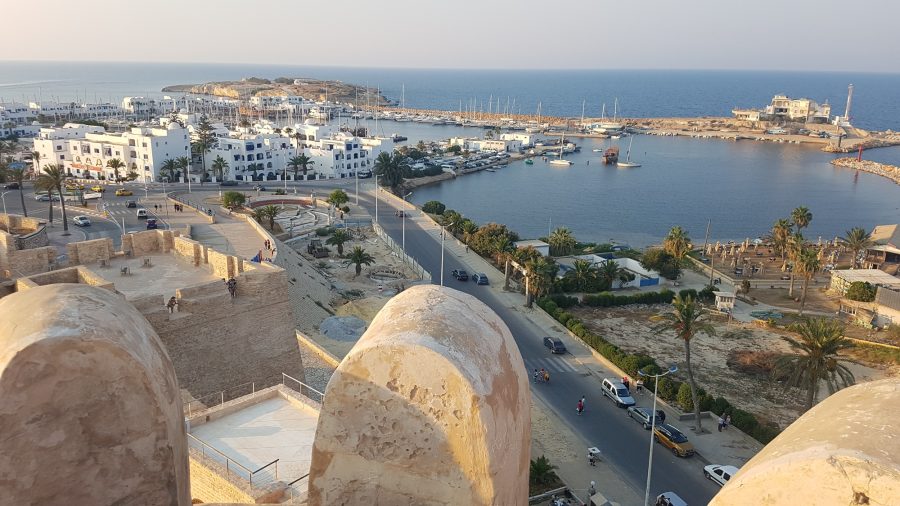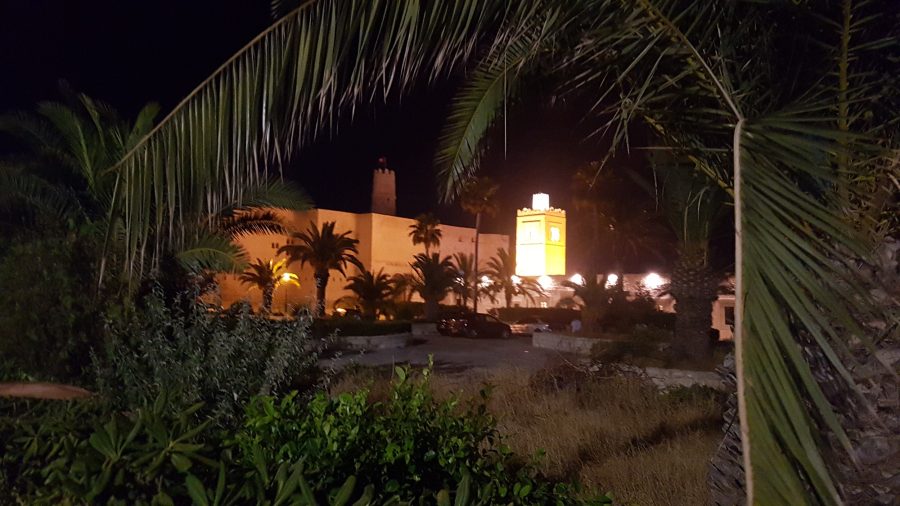When cruising in the Mediterranean, you will often hear cruisers ask “Where are you wintering over this year?” Generally the weather in the Med is dominated by the strong winds that blow down from the north over the European mountain ranges, and funnel through the narrow channels between the many islands. In winter these strong gusty winds are icy cold, and even here in Tunisia, situated on the northern rim of the Sahara Desert, it can be freezing.
So, most of us who plan on spending another season in this part of the world, will find somewhere safe to be secure and comfortable until spring, when the sailing conditions become more favourable. And warmer! Along with dozens of other cruising yachts, we chose to come to Marina Cap Monastir, in Tunisia, on the north coast of Africa. Soon after arriving here, we took a trip home to New Zealand, as described in our last blog. We are now back on board.


Tunisia is a non-Schengen country with a safe marina and good facilities for most types of boat work that might need doing. There is always plenty of that to be done to get ready for another season of sailing.
But this cruising lifestyle is not just about the sailing and boat work, as we love to take time to explore each country, we are in. Tunisia has been a real eye opener and we have learnt so much about this fascinating country, with a population of about 12million. We have loved meeting the beautiful, warm, welcoming people of diverse cultures and tasting their delicious local cuisine.
Tunisia was a French Protectorate from 1881 until Independence in 1956, and the language most spoken here, after Arabic, is French. Although now the young are preferring to speak English and it is fascinating to hear their American accents, learnt from watching American movies.
My daughter Francoise came to visit for Christmas and New Year. Although Tunisia is a Moslem country, and therefore does not celebrate Christmas, we found a restaurant at the marina that was happy to prepare a traditional Christmas dinner for our group of cruisers.


Pictured below in front of the old Arabic fortification of Monastir where Monty Python’s “Life of Brian” was filmed


We rented a car, and with another coupe of cruising friends and Francoise, headed out on our road trip down into the desert in the south, then up north to the Mediterranean coast and to the edge of the Atlas Mountains, between Tunisia and Algeria . Our first destination was the town of Douz, 2 days drive away to the south, to attend the 55th annual International Sahara Festival.

On our way to Douz we we passed by the Amphitheatre of El Jem, a Roman Amphitheatre built around 238AD. Recorded history in Tunisia begins with the arrival of the Phoenicians, in the 8th century BC, then the Romans in 146 BC until the fall of the Roman Empire. Tunisia was invaded by various European tribes until the Muslim conquest in the 7th century. All of these different cultures are evident throughout the country.


Then on to Matmata a region famous for its Troglodyte cave dwellings. We were now entering a totally new landscape of desert, date palms and camels.


In the desert, in the southern part of Tunisia, the Berber people have lived for centuries in underground houses which offer protection against searing summer heat and cold winter winds. Today more than 1200 underground homes have been preserved and some are still used by locals. Our hotel here was inside one of these dwellings. There was no central heating or ensuite bathrooms, but we were very comfortable and made to feel at home. Even Francoise and I had to duck to get through the tiny doors.


Looking from above we see the date palm that is growing up from our hotel courtyard.


This area of Tunisia is one of the most prolific “Star Wars” filming locations and we are able to visit many of the sites.


Next stop Douz, which is a small town, sometimes called the Gate to the Sahara and is surrounded by huge date plantations which produce the most delicious dates. We watched as they harvested these delicious fruits and got to taste some straight from the tree.




There was a real buzz entering the busy township of Douz, as it was market day for the local people and some musicians were adding to the festive atmosphere.






The original inhabitants of Tunisia were descendants of the Berbers, a diverse group of people, indigenous to North Africa who predate the arrival of the Arabs, from about 2000BC.
The 4 day Desert Festival of Douz allows people from Berber tribes from Tunisia, Algeria, Libya and other neighbouring countries to come together to celebrate their rich culture through dance, music, unique dress, horsemanship, camel racing and dog hunting. We joined the crowds to enter the old fort, where the festivities were to take place.


We were in a very different world here and were definitely the only tourists in the crowd. It was an amazing experience and very special as all the people around us were so friendly and welcoming.






Leaving Douz, our drive through the desert took us past more underground towns, Roman baths and another ancient Roman city called Sbeitla. But there is just so much to see everywhere.


We continued on to visit The Great Mosque of Kairouan, one of the largest and most impressive Islamic monuments in North Africa and which is one of the most holy cities of Islam after Mecca, Jerusalem and Medina.


Famous for its hundreds of marble columns which were transported from different Roman cities, already in ruins, nearby. I guess that was the ancient version of recycling and it explains why many of the Roman sites have columns missing. It is also noticeable that the columns are all different.


Leaving the desert behind, our drive north took us up into the hills which are the beginning of the Atlas Mountains. These mountains reach as far as Morocco to the west. The land in this part of Tunisia is wooded, very fertile and so different from the southern desert.
We find a New Zealand connection here at Takrouma Village.


As we drove through the country, we noticed a lovely village perched on a steep hill, not far away. Even from a distance you could see the remains of an old fort on the hilltop. We decided to see what we could find on Google about this village and maybe visit it. Just by chance, we found it had an interesting connection to New Zealand. Who would ever have thought we would find Kiwi history out in this vast rural landscape? We needed to investigate. The views from the top made us understand why this would have been such a strategic position worth fighting for with 360 degree views out to sea, 160kms away, and over to the mountains.


Troops from the 28th Maori Battalion, led by Seargent Haana Manahi, after much fierce fighting, seized the summit, on April 21st 1943. Over 550 New Zealander’s lost their lives here. It was the last major action by NZ troops in North Africa during WW2 before the surrender of Italy and Germany. We felt privileged to be here, to honour those Kiwis, who lost their lives so far from home.
New Zealand Artist, Peter Mcintyre, has a charcoal drawing depicting this attack. This can be seen at a collection of war art at Archives NZ.




Ruins of ancient Roman cities and aqueducts can be seen throughout the countryside, proof of a once thriving civilization.


We didn’t stop to visit them all, but there was one that was distinctly different from any others we had seen.
The Roman city of Bulla Regia, was very wealthy and the homes of the rich were built below ground. These were not caves like we had seen in the south, but a whole city built below the ground. The lower levels were for the wealthy families where they could live protected from the extreme temperatures between winter and summer. The upper levels were for the workers and slaves. Each villa was adorned with stunning mosaics, which are still in situ to walk around. The deep coloured marble used for the columns and the mosaics came from a nearby marble quarry.




Looking down towards the Mediterranean Sea, we arrive at the coastal city of Tabarka with its Genoese fort guarding the entrance.




Our drive south from Tabarka took us through some forests of cork oak. Cork trees grow for about 200 years, and after about 20 years they can be stripped of their bark for about 3 metres without damaging the tree. This can be repeated about every 12 years for the life of the tree. Most of Tunisia’s cork is exported. We also passed road stalls selling all sorts of delicious honey.


We ended our stay in the city of El Kef, built on a hilltop with its 17th century Kasbah overlooking the surrounding area that helps guard the huge fertile fields of Tunisia from any invasion. From the top we can look out over to the Algerian border, 40kms away.


The Kasbah and view over to the Algerian border. The French canons date to the time of Napoleon Bonaparte.


One last place we want to visit with Francoise is the Bardo Museum, in Tunis where many stunning mosaics, tiles and stucco pieces are on display. It was huge and photos will never do justice to the exquisite works of art.




Our holiday is now over and Francoise has left. Now we will begin work on Mai Tai, to prepare for our next season of sailing.
On a personal note, I want to express my deep sorrow on losing my dear brother David who passed away on the 7th December, 2023. Despite our lovely time spent with Francoise, this past month has been very difficult and I still find it hard to believe that he has gone.
Rest in peace, dear brother. You are sorely missed.

Dearest Kay – another incredible chapter of your epic travels. Our thoughts are with you – we can imagine the immense loss and sadness after the passing of your dear brother. Love Judy&Dave
What fascinating reading, and stunning photos ! You certainly make the most of every moment !
Thank you again,what a wonderful trip and to experience it all with Francoise even more special.those freshly picked dates would have been delicious.always thinking of you.LB
What an amazing journey you have made through Tunisia, and I thought that I had “seen it all”. Those cork forests definitely interest me, anything GREEN! I’m very sorry about the passing of your brother, Kay, and was glad to see that your daughter Frankie was here to be with you, during what was a difficult time.
I love the star wars .. Luke’s home!.. so cool.. have a great winter stay and keep warm.. sorry to hear about your brother Kay..
all is well here.. just living the grind
Dear Lane and Kay,
Thank you for sharing your wonderful adventures with us.
It must have been wonderful to have your daughter to have your daughter with you for her to experience some of the sights together.
I so enjoy your blog and always look forward to the next adventure and all of the pictures.
Stay safe, until next time.
Lots of Hugs,
Judy Lowe